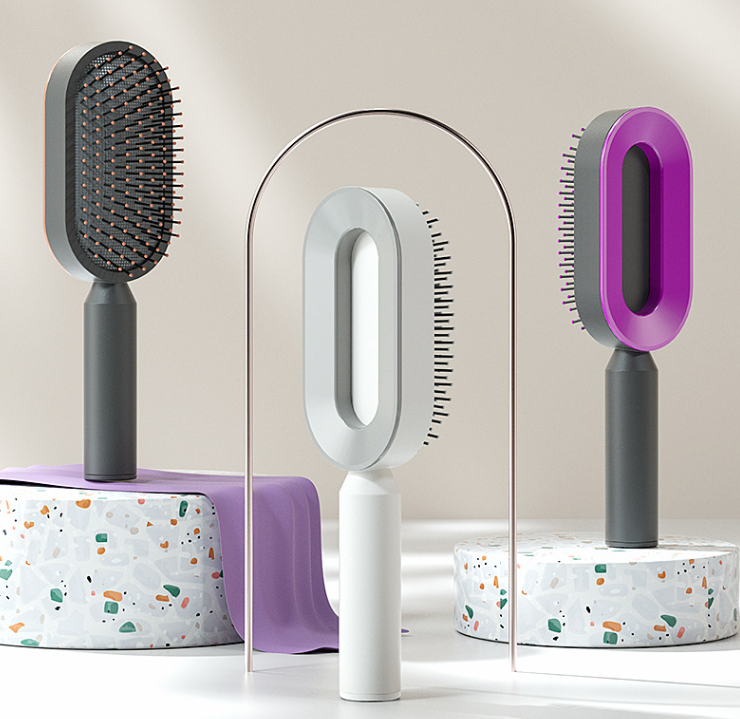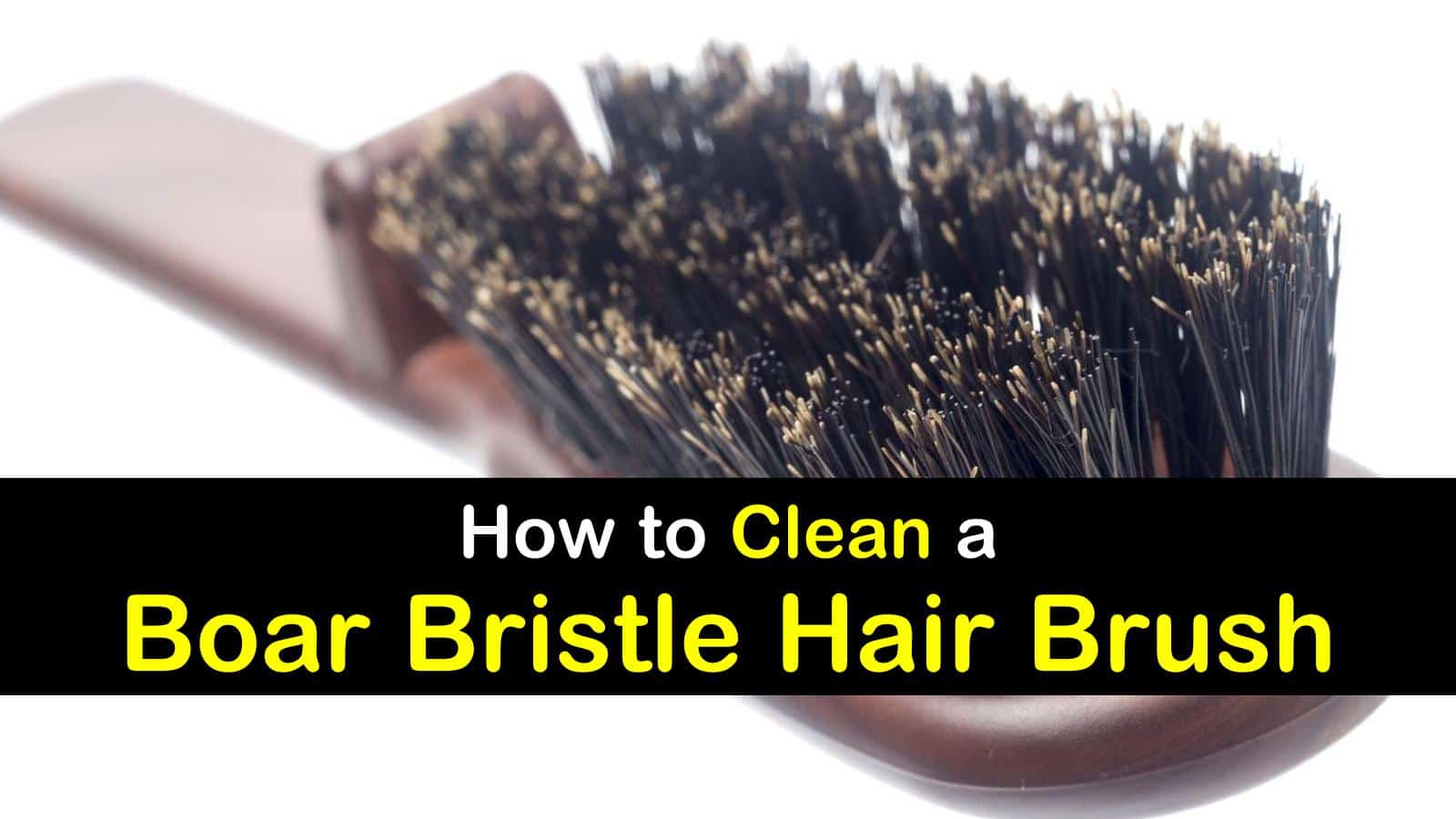Table Of Content

Place your plastic brush in to soak or swirl your boar-bristle brush. "Next, rinse the remaining soap and loosened debris out and use your comb again to make sure no dirt is left behind. Shake it out and place it face down on a towel to dry." A thorough monthly cleaning is sufficient for most hairbrushes and combs.
Make a soapy cleaning solution
Brushes with synthetic (plastic) bristles and handles are the easiest to clean, while natural bristles or wooden-handled brushes require more careful attention. No matter what type of brush you use, start the cleaning process by first removing all of the shed hair that’s stuck in the bristles of your brush. You can use your fingers, a wide-tooth comb, or a rat-tail comb to remove the hair from the brush bristles. You'll want to carefully remove the hair as to not damage the brush's bristles, especially if you have long hair or curly, coiled hair that can get tightly intertwined in the bristles. Be sure to slowly slide the shed hair upwards from the base of the brush through the bristles to remove it. Take special caution with wooden brushes to avoid pulling up the adhesive that keeps the bristles in place.
How to Clean a Synthetic Comb
How to Clean a Hair Brush in 2022 - Easy Ways to Sanitize Brushes - Cosmopolitan
How to Clean a Hair Brush in 2022 - Easy Ways to Sanitize Brushes.
Posted: Thu, 19 Nov 2020 08:00:00 GMT [source]
Its sulphate-free formula means it gets the go-ahead for natural bristles and the 500ml bottle means it’ll last ages, too. For the least amount of mess, we’d suggest doing this over a bin or sink to catch the dust and dead skin cells that are dislodged. The baking soda and white vinegar method takes a bit of elbow grease, but it'll get even the filthiest brushes clean. Fill a bowl or your bathroom sink with warm water and a squirt of gentle shampoo. When you’re satisfied with the cleanliness of your hairbrush, rinse it well. You can even add a bit of vinegar to the rinse for an extra clean.
Uh, What is This Gross Dust Covering My Hairbrush, and How Do I Get It Off?
For someone at home, she suggests using this spray one to two times per week. But aside from taking out the hair and maybe running it under water (if we're feeling ambitious), most of us rarely even think about giving it a good scrub. That's why, during some recent TikTok scrolls, I was shocked when I came across multiple videos of people not just rinsing it, but actually taking out the bristle pad, soaking it and giving the brush a deep clean. Follow these simple steps to keep hair shiny and healthy with a properly maintained brush. For insight on tending to your hairbrush, we consulted a trichologist—an expert in skin and hair—and two hairstylists who clean dozens of brushes a week. While a good cleaning and a maintenance routine can help keep your hairbrush in good shape, there comes a time to retire your brush.
Cleaning lint and strands of hair out of a hairbrush is simple. According to the American Academy of Dermatology, it’s normal to shed 50 to 100 hairs a day. No matter how often you use your hairbrush, it has the ability to act like a sponge. This means it can trap all sorts of residue in its bristles, both from your hair and from the environment. Soiled grates are not only unsightly, they're actually unsanitary and unsafe.
Do you really need a 'smart' hair brush? - Reviewed
Do you really need a 'smart' hair brush?.
Posted: Tue, 10 Jan 2023 23:20:08 GMT [source]

“Gently pat the hairbrush with a clean towel to remove excess water and let it air dry completely before using it again,” says Kate. The narrow teeth on this pocket comb mean that it’s able to pick up dust, debris and dead skin cells on the base of the brush with ease. Plus, it’s super affordable, so if you don’t fancy reusing it for anything else, it won’t make much of a dent in your beauty budget. Everyone knows how to wash their hair but have you ever considered how to clean your hairbrush properly? No judgement if not because the thought doesn’t often enter our heads either. It turns out, however, that keeping your brush head as clean as, well, your actual head, is an important part of maintaining happy, healthy scalps and hair.
“When it looks old and tired and completely worn out — that is when it is time to say goodbye and invest in a new hairbrush,” Faulk advised. Next comes the actual cleaning part, and there are tons of methods to try. Keep reading to learn how to clean plastic and boar-bristle brushes. While it's commonly said that you shouldn't brush your curls, one hair stylist previously told us that this brush is the exception. It has strong bristles, which he said helps cut down on detangling time and helps evenly distribute your curl products.
If you soak your brush with all that hair in it, you'll just have a nasty mess. And to help you get there, I broke down the three best tutorials on YouTube for easy, effective cleaning. Good Housekeeping participates in various affiliate marketing programs, which means we may get paid commissions on editorially chosen products purchased through our links to retailer sites. Make sure you have these tools on hand before you tackle this beauty chore. Madeleine, Prevention’s assistant editor, has a history with health writing from her experience as an editorial assistant at WebMD, and from her personal research at university. She graduated from the University of Michigan with a degree in biopsychology, cognition, and neuroscience—and she helps strategize for success across Prevention’s social media platforms.

Use a toothbrush for extra cleaning
Here are more household uses for vinegar, while you have it out. Fill a bowl or your bathroom sink with lukewarm water and a squeeze of shampoo or mild dishwashing liquid. Start by using your fingers to pull up hair that’s already close to the top. Then use a pintail comb, tweezers or a brush-cleaning tool to pull hair that’s stuck to the base of the brush.
Like the rest of the skin on your body, your scalp regularly rejuvenates itself, and dead skin cells can slough off. If you brush your hair regularly, you’re both helping and encouraging the process. This means you might notice tiny cells form into larger clumps on your brush over time. If you don’t clean your brush often, that lint buildup might eventually turn gray. “First, make sure to remove all hair and debris from the bristles,” Faulk explains. If you’re already in the groove of cleaning your brushes, you may be able to do this with your hands.
Although the Cadillacs of boar-bristle brushes have price tags that soar pretty hiiiigh, there are still a ton of great options for those not looking to spend major dough on their first go-around. This 100 percent boar-bristle brush by Conair is specially made for fine and sensitive scalps. The really fine bristles work to gently distribute the scalp's natural oils throughout the hair. The brush is also incredibly versatile and can be used as a detangling wet brush, a blow-drying brush, or just an everyday staple.
Just like your toothbrush, your hairbrush can harness bacteria if it isn't cleaned on a regular basis. Depending on how often you use it and what type of hairbrush it is, you may need to clean it anywhere from once a week to once a month. If you use a plastic or laminate brush, you can submerge it in the suds. You may notice some of the fuzz is starting to loosen from your brush’s surface, and your sink might look a bit cloudy.
Alternatively, he notes that a rake comb or rat-tail comb are helpful tools to use for removing shed strands — especially for those brushes with super dense bristles. With a few simple steps, you can eliminate the potential breeding ground of dirt and bacteria on your favorite hairbrush and be on your way to healthier hair. Here's exactly what to know about the best practices for cleaning hairbrushes and maintaining a healthy scalp, so that you can achieve healthier hair from root to tip.
With a combo of flexible massaging bristles and natural boar, this brush will leave your hair all soft and smooth, and tangle-free. The last thing I want to do when I get out of my "everything" shower is to have to detangle my hair. But when I discovered Wet Brush, it was like the tangled hair angels heard my cries.
If you have a particularly gunky brush, you can add a bit of baking soda to your toothbrush before scrubbing. On another note, here is how often you need to change your toothbrushes. You’ll first want to become more diligent about removing the shed hair every time you use your hairbrushes. Removing the excess hair buildup helps prevent unnecessary tugging or snagging on shed hair that's been left in the bristles, says James. Weekly brush cleaning is especially a necessity if you're experiencing an itchy, red inflamed scalp; that way, you ensure you're not causing any additional irritation. Dr. Piliang recommends the average person clean their brush every one to two weeks.

No comments:
Post a Comment